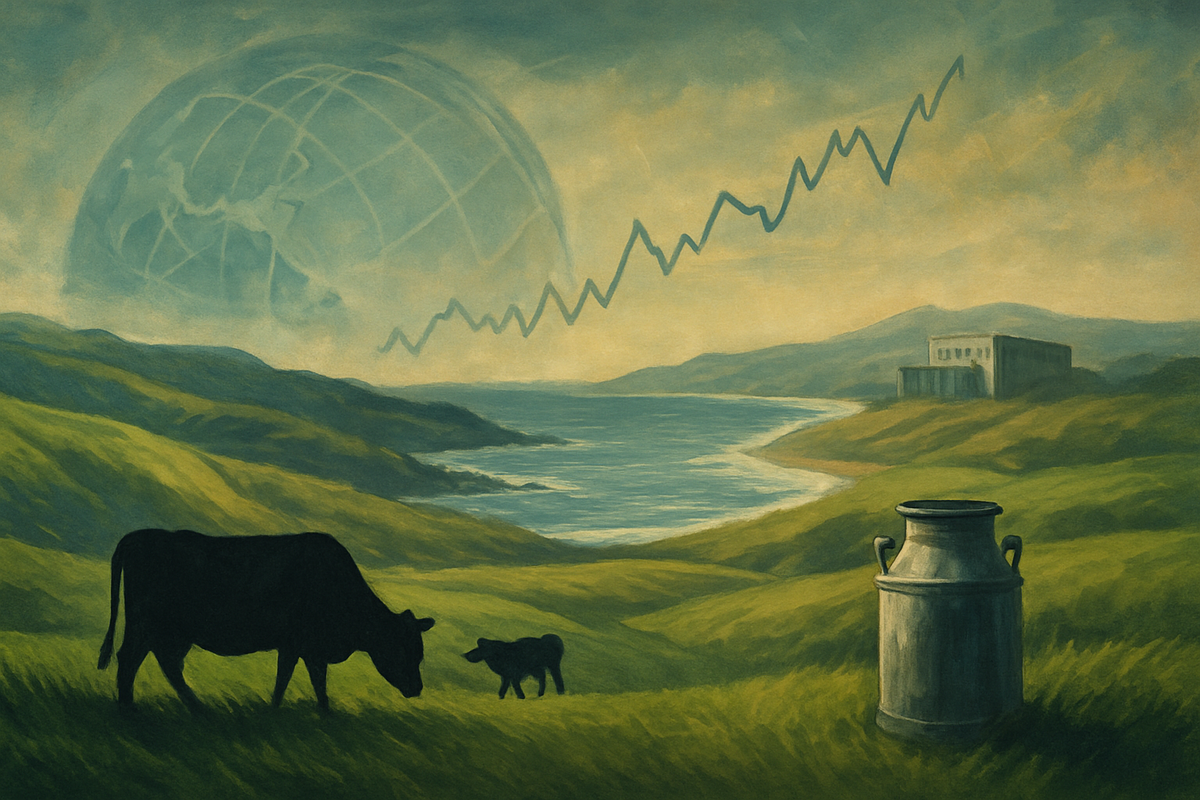
Wellington, New Zealand – October 29, 2025 – New Zealand's economic landscape in October 2025 is navigating a complex and volatile global commodity market, where soaring meat prices offer a significant buffer against sliding dairy values and a broader decline in overall commodity forecasts. This mixed bag of international price movements is intricately shaping the nation's trade balance, influencing its inflation trajectory, and providing the Reserve Bank of New Zealand (RBNZ) with room for an increasingly accommodative monetary policy. As a nation heavily reliant on primary sector exports, the ebb and flow of these global markets are proving to be the dominant force dictating New Zealand's near-term prosperity and strategic economic direction.
The overall trend points towards a general decline in global commodity prices into 2026, driven by weak global economic growth and an emerging oil surplus. However, the immediate picture for New Zealand is nuanced. While robust demand and constrained supply have propelled global meat prices to historic highs, providing a strong tailwind for New Zealand's beef and sheep-meat exporters, the crucial dairy sector faces headwinds with sliding prices for key products like butter and nonfat milk. This divergence creates a delicate balancing act for the economy, impacting export revenues, influencing domestic cost pressures, and ultimately guiding the RBNZ's proactive stance on interest rates.
A Divergent Commodity Market: Highs, Lows, and Economic Ripples
The global commodity narrative in October 2025 is one of stark contrasts, with New Zealand finding itself directly in the crosshairs of these powerful, often conflicting, forces. While the broader forecast indicates a multi-year decline in overall commodity prices, specific sectors critical to the Kiwi economy are experiencing unique trajectories, creating both significant opportunities and considerable challenges.
At the forefront of the positive developments are global meat prices, which have surged to unprecedented levels. Beef prices, in particular, have not been this high in over six decades, fueled by a severe contraction of cattle herds globally, most notably in the United States, which is grappling with its lowest cattle numbers since 1951 due to prolonged droughts and elevated feed costs. Similarly, sheep-meat prices are on a consistent upward trend, driven by tight export supplies from Oceania. This sustained demand and restricted supply are expected to keep meat prices elevated well into 2026, offering a substantial boost to New Zealand's agricultural export earnings. For a country where meat exports constitute a significant portion of its primary sector, this sustained strength is a critical economic stabilizer.
Conversely, the global dairy market presents a more challenging outlook. Despite upward revisions in forecasts for global dairy cow numbers and total milk production for 2025 and 2026, prices for key dairy products like butter, cheese, and nonfat milk are currently sliding. While whey shows surprising strength, the overall sentiment for major dairy components is downward. New Zealand's milk production saw a 2.5% year-over-year increase in August 2025, but lower global prices could prompt local dairy producers to tighten belts and potentially increase culling to manage costs, especially given the attractive beef prices. This downward pressure on dairy revenues, a cornerstone of New Zealand's export economy, could partially offset the gains from the robust meat sector, leading to a mixed impact on the nation's overall trade balance.
Beyond agriculture, other commodity movements are also playing a role. Oil prices are projected to decline significantly into 2026 due to a growing global surplus, contributing to an easing of tradables inflation. However, fertilizer prices are forecast to surge by 21% in 2025, driven by higher input costs and trade restrictions. This increase in input costs will directly impact New Zealand's agricultural sector, potentially leading to higher domestic food prices even as other global commodity prices ease. Shipping costs remain volatile, with the Red Sea crisis continuing to cause rerouting and increased transit times, though a broader forecast suggests a slight decrease in average global freight rates. The RBNZ, observing these trends, has proactively cut its Official Cash Rate (OCR) by 50 basis points to 2.50% in October 2025, an aggressive easing measure aimed at stimulating the domestic economy amidst weak Q2 GDP and mild inflation expectations, while closely monitoring the interplay between global commodity prices and persistent domestic non-tradables inflation.
Winners and Losers: Corporate Fortunes Tied to Global Markets
The divergent paths of global commodity prices are creating clear winners and losers among New Zealand's public companies, particularly those deeply embedded in the primary sector. Their fortunes are directly tied to the specific commodities they produce, process, and export, demanding strategic agility in this volatile environment.
Dairy giant Fonterra Co-operative Group Limited (NZX: FCG), as New Zealand's largest exporter, stands at a critical juncture. While the overall increase in global milk production could theoretically boost their output, the sliding prices for butter, cheese, and nonfat milk pose a significant challenge to their revenue and profitability. Although they might benefit from stronger whey prices and potentially reduced input costs from lower oil prices, the core dairy commodity price weakness will likely put pressure on their farmgate milk price payouts and overall financial performance. The company will need to focus on value-added products and efficient operations to mitigate the impact of the lower commodity prices on its bottom line.
Conversely, companies heavily invested in the meat sector are poised to be significant beneficiaries. Major meat processors and exporters such as Alliance Group Limited (unlisted, but a key player) and Silver Fern Farms Limited (unlisted, but a key player) are experiencing a boom. The historically high global prices for beef and sheep-meat, driven by constrained global supply and strong demand, will translate directly into increased export revenues and improved margins for these companies. This robust performance could also trickle down to individual farmers, bolstering their profitability and capacity for investment. While these are not publicly traded in the same way as Fonterra, their performance is critical to the wider agricultural economy and will indirectly impact related service providers and investors in agricultural funds.
Beyond the primary producers, companies involved in agricultural inputs face mixed prospects. The projected surge in global fertilizer prices will likely increase operating costs for many agricultural businesses, including those supplying to dairy and meat farms. This could squeeze margins for both the farmers and the input suppliers, unless these costs can be passed on. On the other hand, a weaker New Zealand dollar, a consequence of the RBNZ's OCR cuts, generally benefits all exporters by making their products more competitive internationally and increasing their local currency earnings from foreign sales. This currency depreciation acts as a partial hedge against some of the commodity price volatility. Companies with diverse export portfolios or strong hedging strategies will be better positioned to navigate these fluctuating market conditions.
Broader Significance: Beyond the Farm Gate
The current dynamics in global commodity prices extend far beyond the immediate financial statements of New Zealand's primary sector companies, resonating throughout the broader economy and influencing national policy. This scenario underscores New Zealand's inherent vulnerability and resilience as a commodity-dependent economy, fitting into long-standing patterns of boom and bust cycles.
Historically, New Zealand's economic trajectory has been closely correlated with global commodity prices, particularly for dairy and meat. Periods of high prices have typically spurred economic growth, boosted national income, and supported a stronger New Zealand dollar, while downturns have often led to economic slowdowns and increased fiscal pressures. The current situation, with strong meat prices offsetting weaker dairy, represents a diversification within the agricultural commodity basket, providing a degree of insulation against a complete commodity-led downturn. This partial hedge highlights the importance of New Zealand's diverse agricultural output in mitigating risks.
The RBNZ's aggressive monetary policy response, cutting the Official Cash Rate (OCR) to a three-year low of 2.50% in October 2025, is a direct acknowledgement of these global forces. The expectation of easing tradables inflation due to declining overall commodity prices, particularly energy, provides the central bank with the necessary headroom to stimulate the domestic economy. This policy decision also reflects a broader global trend among central banks in advanced economies, where some are beginning to pivot towards easing as inflation pressures moderate from their post-pandemic peaks, albeit with careful consideration of persistent domestic price pressures. The RBNZ's proactive stance aims to ensure inflation returns sustainably to its target band while supporting economic activity.
Potential ripple effects are evident across various sectors. While lower oil prices are a boon for transportation and manufacturing costs, the surge in fertilizer prices will inevitably increase operational expenses for farmers, which could eventually translate into higher domestic food prices, even as global food commodity prices might ease. The volatility in shipping costs, exacerbated by geopolitical events like the Red Sea crisis, continues to pose challenges for all exporters and importers, adding an element of uncertainty to supply chains and trade margins. Regulatory bodies will be closely monitoring these developments, particularly regarding potential impacts on food security and affordability, and may consider targeted support measures for affected industries or consumers if inflationary pressures from input costs become too severe.
What Comes Next: Navigating Uncertainty and Opportunity
Looking ahead, New Zealand's economic path will remain heavily influenced by the trajectory of global commodity markets, demanding strategic foresight and adaptability from both policymakers and businesses. The interplay of ongoing global economic growth, geopolitical stability, and supply-side dynamics will dictate the short-term and long-term possibilities.
In the short term, the divergence between robust meat prices and softer dairy prices is likely to persist. Meat exporters will continue to capitalize on strong demand and constrained global supply, potentially driving further investment in processing capacity and herd expansion, albeit a multi-year endeavor. Dairy companies, on the other hand, will need to focus on cost efficiencies, product diversification into higher-value segments, and exploring new markets to mitigate the impact of lower commodity prices. The RBNZ is expected to maintain its accommodative monetary policy, with further OCR cuts possible if domestic inflation pressures continue to ease and economic growth remains subdued. Investors should watch for the RBNZ's forward guidance and upcoming inflation reports for signals on future rate decisions.
Longer term, the global economic outlook remains a critical determinant. A sustained period of weak global growth could further depress overall commodity prices, potentially eroding the gains from the strong meat sector. Conversely, a rebound in major economies could reignite demand across the board. Strategic pivots for New Zealand companies will involve deepening market access, particularly in Asia, and investing in sustainable and resilient supply chains to withstand future shocks. There is also a growing opportunity for New Zealand to enhance its reputation as a supplier of premium, sustainably produced agricultural products, leveraging its environmental credentials to command higher prices in discerning markets.
Potential scenarios range from a "soft landing" where global commodity prices gradually stabilize, allowing New Zealand's economy to rebalance, to a more challenging "prolonged downturn" if global demand falters significantly. A "commodity super-cycle rebound" remains a less likely but positive scenario, driven by unexpected global growth or widespread supply disruptions. For New Zealand, adapting to these scenarios will involve continued government support for innovation in the primary sector, diversification of export markets, and robust fiscal management to build resilience against external shocks.
Wrap-Up: Resilience in a Volatile World
October 2025 finds New Zealand's economy in a state of carefully managed equilibrium, largely dictated by the powerful and often conflicting currents of global commodity markets. The key takeaway is the nation's inherent resilience, underscored by the strong performance of its meat sector which is providing a crucial counterweight to the more challenging environment faced by dairy. This divergence highlights the importance of New Zealand's diversified agricultural export base in navigating global economic volatility.
Moving forward, the market will remain acutely sensitive to shifts in global demand, particularly from key trading partners in Asia, and to any further supply disruptions in major commodity-producing regions. Investors should closely monitor the quarterly reports of major agricultural companies, paying particular attention to their export volumes, realized prices, and hedging strategies. The RBNZ's monetary policy decisions will also be a critical watch point, as its actions will continue to shape domestic economic conditions, including lending rates and the value of the New Zealand dollar.
Ultimately, New Zealand's ability to adapt to these global forces, by fostering innovation, pursuing market diversification, and maintaining sound macroeconomic policies, will determine its long-term economic stability and prosperity. The current commodity landscape is a stark reminder that while global markets can present significant challenges, they also offer substantial opportunities for those agile enough to seize them.
This content is intended for informational purposes only and is not financial advice






